You Know Why - Now Decide What
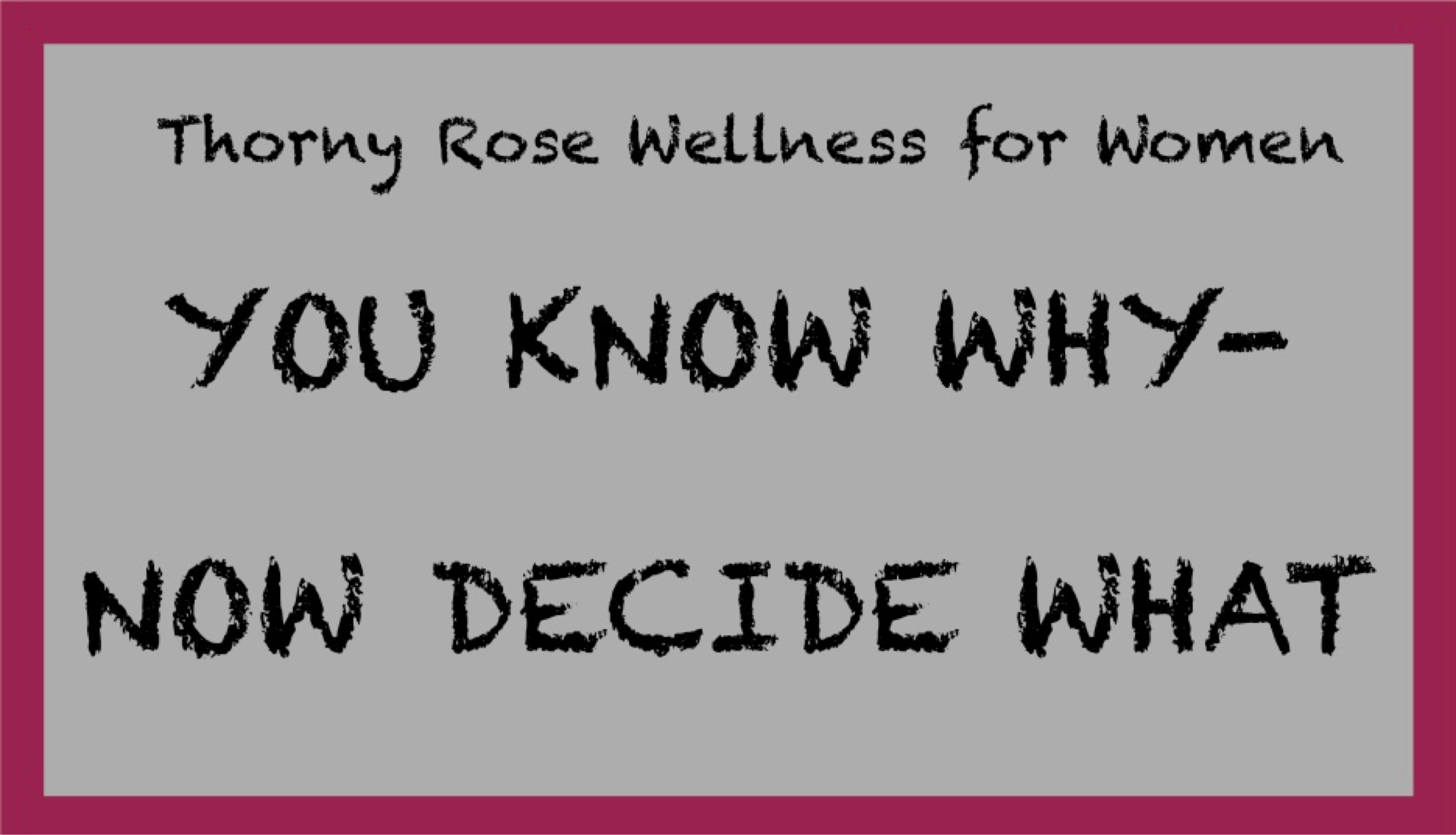
So you’ve been bludgeoned with facts about how excellent exercise is for you.
You’ve been targeted relentlessly by the magnesium marketing board.
You get that your gut microbiome benefits from a diversity of plants and fermented foods.
You know the Power of Protein.
You know how important sleep is to just about every function of your body and mind.
Not least of all how it affects your stress hormones.
You know the valuable jobs oestrogen, progesterone and testosterone do for you, and if your ovaries are in a well-earned retirement, you are working out alternative ways to get those jobs done still, one way or another.
You’ve smoked out your objections, cleared your barriers
You’ve been engaging with the exercise videos I send you daily. You have, haven’t you? Been doing them every day? Or at least, when you can.
You’ve sorted out a system for tracking your progress
You’re ready to embrace the identity shift involved in really looking after YOU.
In other words…….. you’ve been laying some excellent foundations.
And what are your thoughts about your long term plans?
Are there things you would do if you were a bit fitter?
Are there things you would do if you had more energy?
Is there something you would love to do, a challenge you’d love to undertake?
Or would you like to focus on those incremental changes that add up to make significant change in your life?
And, something to be aware of, what is the shape of the curve of your progress?
If we consider exercise, for many people, this is about maintenance. They might start from a place of not being very fit, put a lot of effort in, get to a good level of fitness, and then settle at that point. In fact, they will settle a little lower than that because of adaptive thermogenesis. Essentially, you get more efficient at something you do often and as a result it takes less effort and so your fitness drops a little. The graph would look a bit like this.
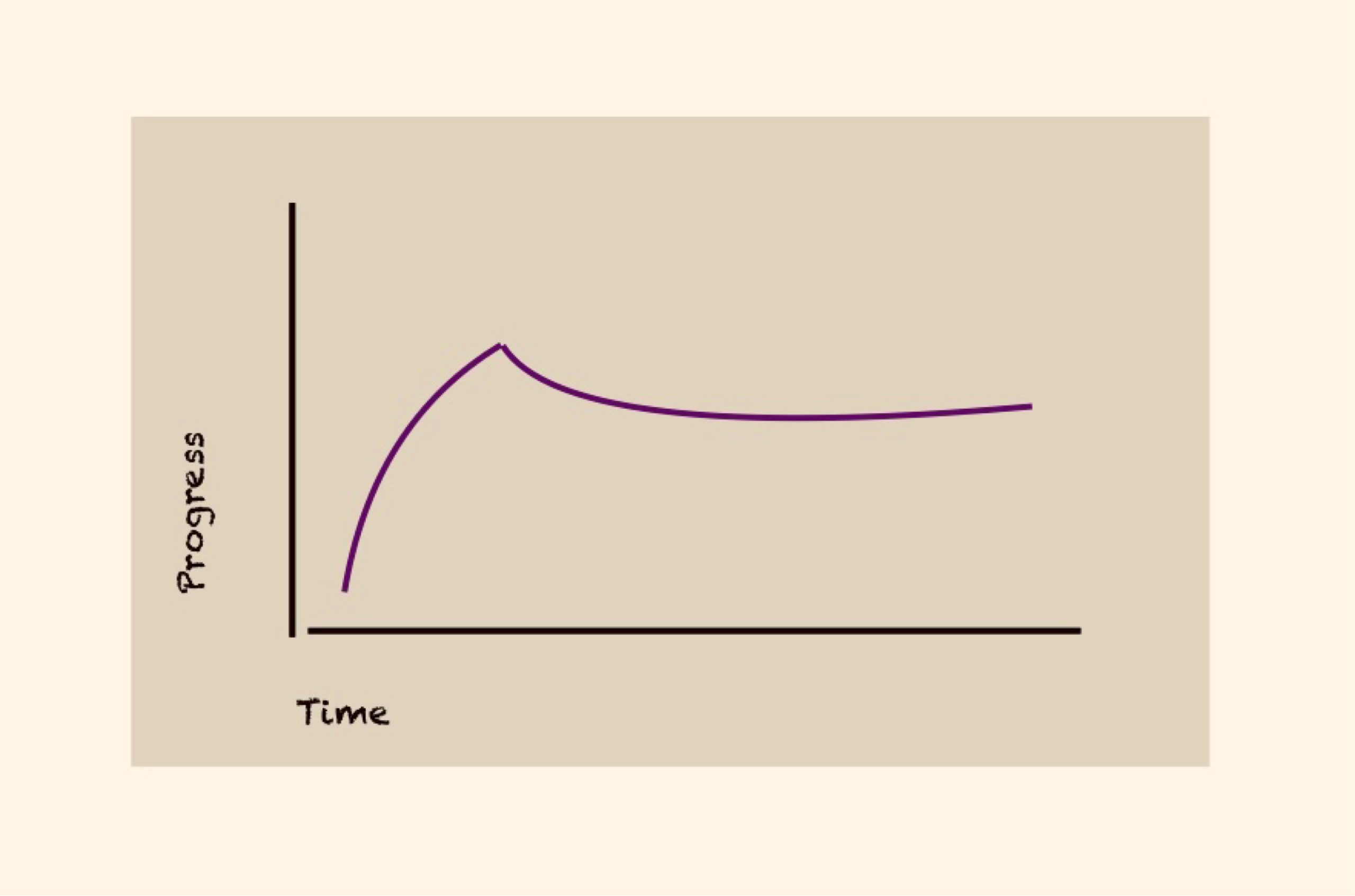
In all honesty, for most people this is absolutely fine. Maintenance will do the jobs that you need doing, and keep things in order quite nicely. You will get all the amazing benefits of regular exercise. There could be a few dips here and there if there were an injury, or go up a bit if you were suddenly more busy in the garden, but it’s not a bad place to aim for.
Quite commonly, people have something specific they want to get fit for. Maybe an activity they want to be able to take up, or an event they want to do, such as a Park Run or a 10k. This might be the thing that gets them up to a certain level of fitness which they can settle at, or it might be a stepping stone to a higher goal (be warned, this stuff can be addictive). But you can’t get infinitely fitter. And actually, generally people can’t sustain peak fitness over time. It’s probably not even ideal (extreme endurance events don’t add to your longevity, on the contrary, they shorten it), and so these people will probably settle at a level quite a lot lower than their peak.
It’s more usual to have a more cyclical graph than that. If people are extremely busy with a new job, or a new baby, their health and fitness might well dip down quite substantially, especially if this corresponds with the winter months. Then, perhaps feeling the ill-effects of a less healthy lifestyle, and perhaps the onset of spring, they might be inspired to prioritise their health more. Or indeed, for some people there is an annual pattern of eating less healthily and moving less in the winter, and getting out more and eating better in the summer.
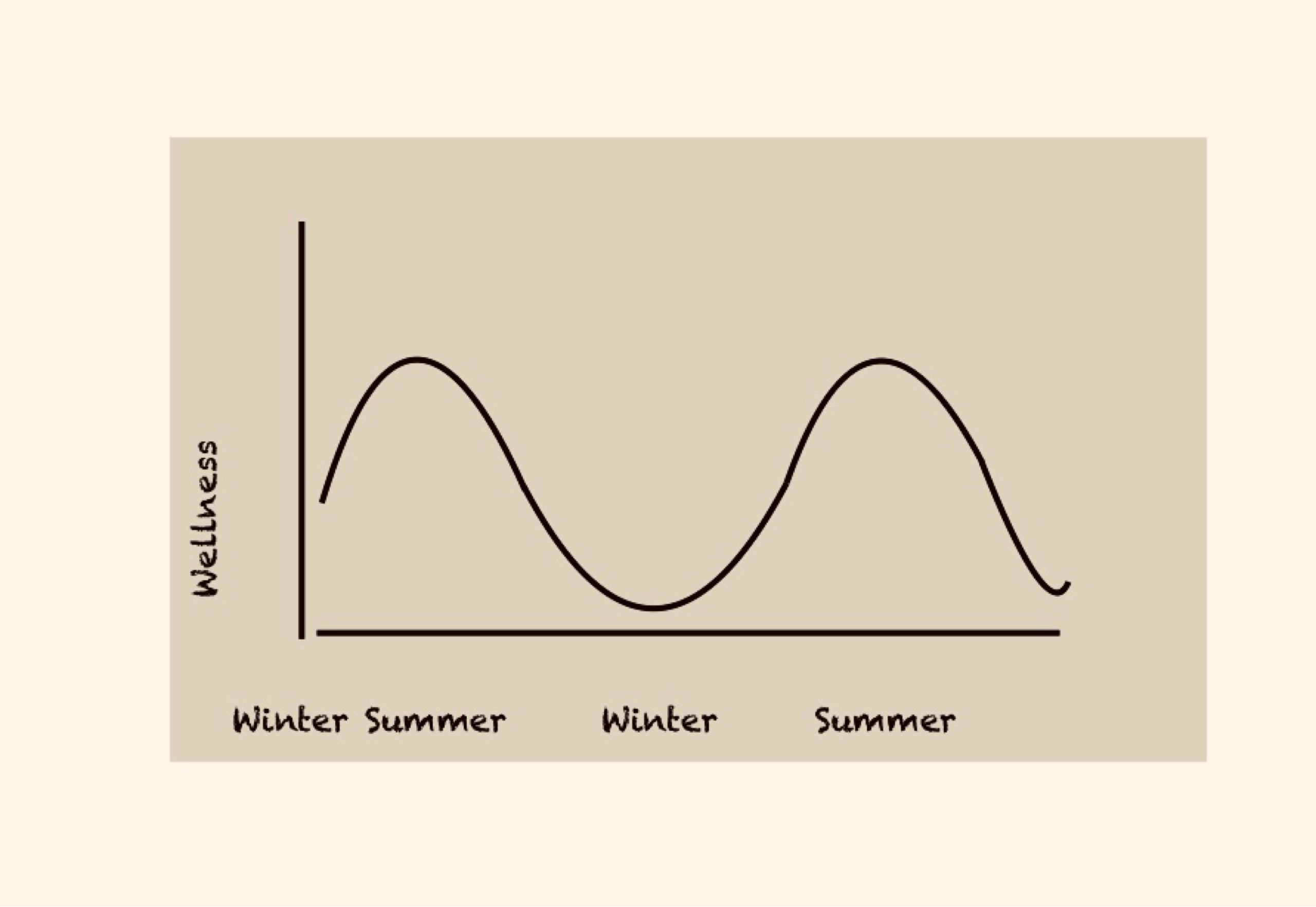
It might be that you find ways of shallowing that cycle - so that the winter dip is less of a dip. Or it might be that you embrace it. You recognise it. You synchronise more with the seasons. Honestly, I don’t know which is the right way, especially for you. Winter might well be a time for more rest, for going more within yourself, for embracing long evenings by the fire, but it doesn’t have to be all or nothing. You can still enjoy the invigoration of a wild windy stomp up a hill, or the remarkable benefits of frequent, brief, movement.
And what are we talking here? Goals? Resolutions? Aims? Intentions? Plans? Habits? And do we have the strategies to implement them?
You’ve probably come across SMART goals. The acronym appears in lots of different contexts - most notably business, but also in the fitness world. It might be a bit tedious to frame all your goals in this way, but the reasoning behind it is that stating your goals in a specific and measurable way, with a time frame attached, makes it easier to plan what to do and to know if you have achieved it.
So “I want to eat more healthily” is a bit too vague to be helpful. You might well have a fair idea of what that means to you, and just stating the aim is likely to lead to more conscious choices, but a SMART goal would be
Specific: I want to ensure I eat 30 different plants each week
Measurable: you can easily count how many you are in fact eating
Attainable (or achievable): yes, I have control over my food intake this week (not away on travel, for instance)
Realistic: yes - because even spices and coffee count
Timely: is there a time frame specified? Yes - a week.
You can think of goals as process orientated or results orientated.
A process oriented goal is “I will exercise three times a week, in addition to my daily reps”, or “ I will eat 50g more of fibre every day.” Or the example above of eating 30 plants each week. These have the advantage of being very easy to measure. And the “so that” is taken care of quite easily because you have already worked out the whys involved. Adding more fibre, or 30 plants, to your diet is a really good thing to do. You can just go ahead and do it. You can set aside some time 3 times a week to do something that you have defined as exercise.
Results orientated goals can be easy to measure, but they can be harder to achieve. You have hit your process orientated goal if you do the process, but you could put quite some effort into achieving a results goal and not get there, especially if the goal was harder than you thought it would be.
For instance, you might set a goal to be able to do ten pull ups in a row in a month’s time.
If we run that through the SMART test:
Specific - yes, and you could be more specific by saying unassisted, or full, or a particular type of pull up
Measurable - yes, you can count how many you can do
Achievable/Attainable - well, arguably yes, if you have two arms and a pull up bar, you could attain this goal. Other people have done so. There is precedent. It is something that is humanly possible.
Realistic - well, now, that depends very much on where you are starting from, but actually, no, it’s quite likely to be unrealistic. In the video here, these already quite fit and active women needed 6 weeks to do one full pull up. Ten is almost certainly too many, especially if you aren’t already quite active.
Timely - yes, you have specified a time, but actually 6 months would be a more realistic time frame.
So if you set yourself this results-orientated goal without understanding that the challenge is in fact quite an unrealistic one, you could be disappointed and disillusioned by your inability to manage it, and discouraged from continuing.
It might be better to set a process orientated goal where you commit to a programme that would take you to a good place to achieve a pull up, and see where you are at the end of that. Maybe you aren’t quite at the pull up stage, but you for sure are closer, and you might well have a good understanding of what you might still need to do to get there.
Some of the changes you might want to make to progress you towards better health are better stated as habits, because they are open-ended and intended to be permanently incorporated into your life.
Certainly it's true that what you do daily has the biggest effect on the outcome than what you do once in a while.
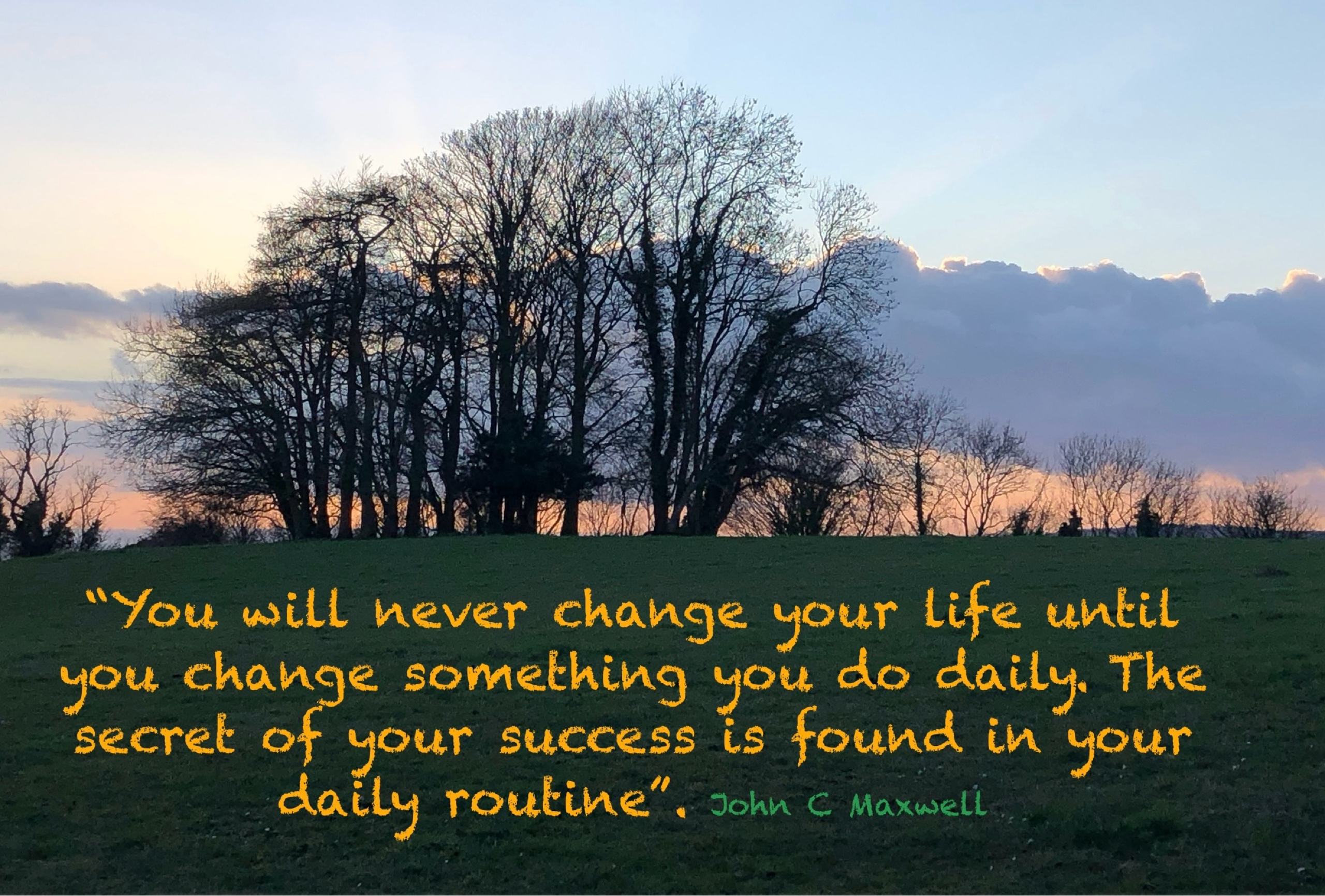
If you aren’t convinced by the benefit of a habit, it can be helpful to set out a time frame and commit to the habit for that length of time. You would probably want to do some research to help you decide on the time frame. If it turns out that you need to supplement with low levels of oestrogen for three months before you feel any benefit and consider changing the dose, then three months (plus the next tranche of time) makes sense as the time scale. If you should expect to experience the benefits of maca root within a fortnight, then three weeks (to be on the safe side) might be good. I chose 3 months as the time frame to see how daily cold water exposure affected me, although I kept going for a bit longer as I found it so beneficial.
Choosing a finite time frame in this way makes it easier to commit. If you aren’t particularly enjoying the habit, you know you can stop at the end of the allotted time, but you also know that as you persist you might perhaps grow to like the habit after all.
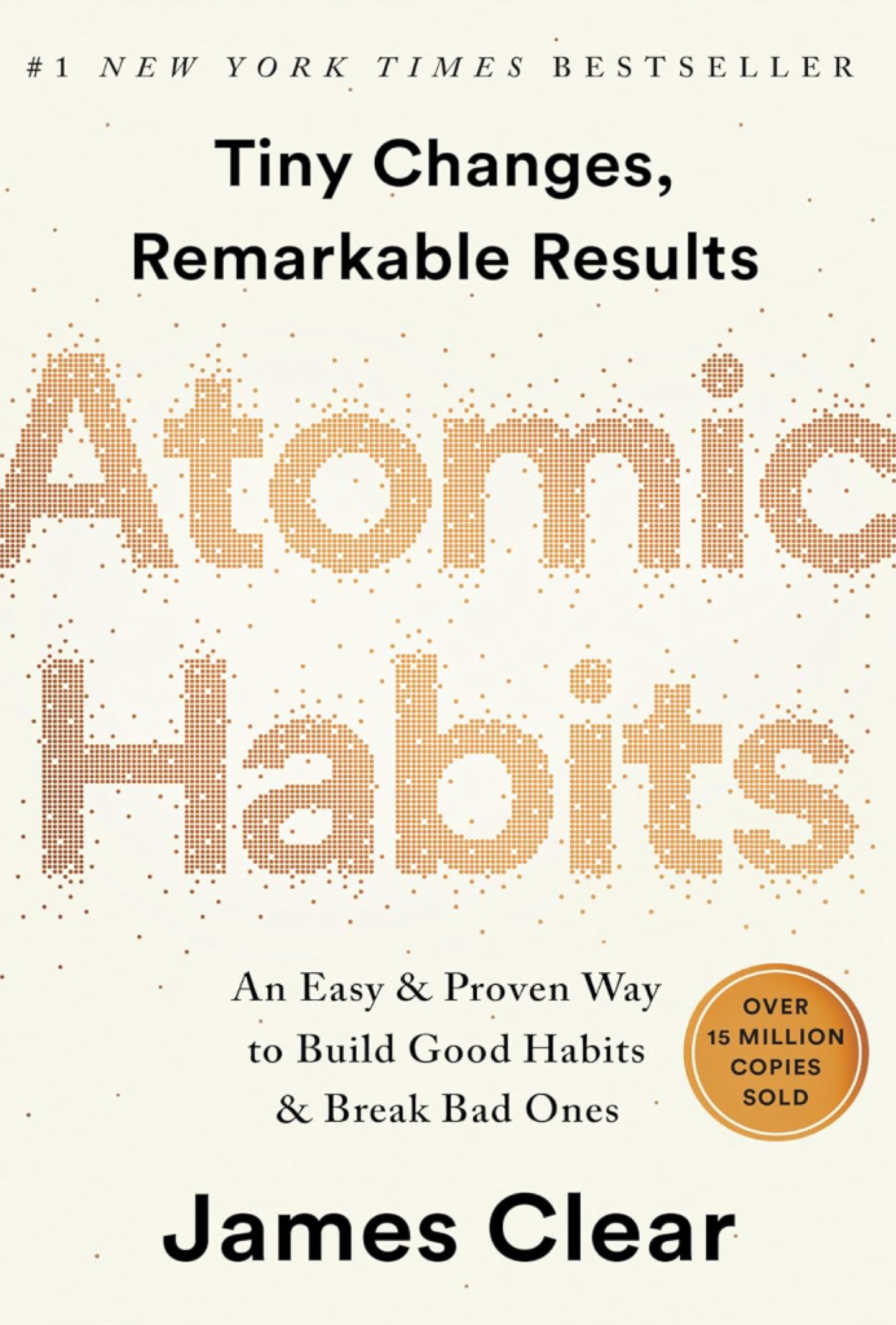
Many people find the book Atomic Habits, by James Clear to be helpful. Of course, it depends on how many such books you have already read as to how novel the advice in them might seem, but two of the takeaways from that book that people often mention is the idea of making incremental improvements, that add up over time, and habit stacking.
Here’s an article written by James Cleary on Habit Stacking, and here's one on 1% improvements
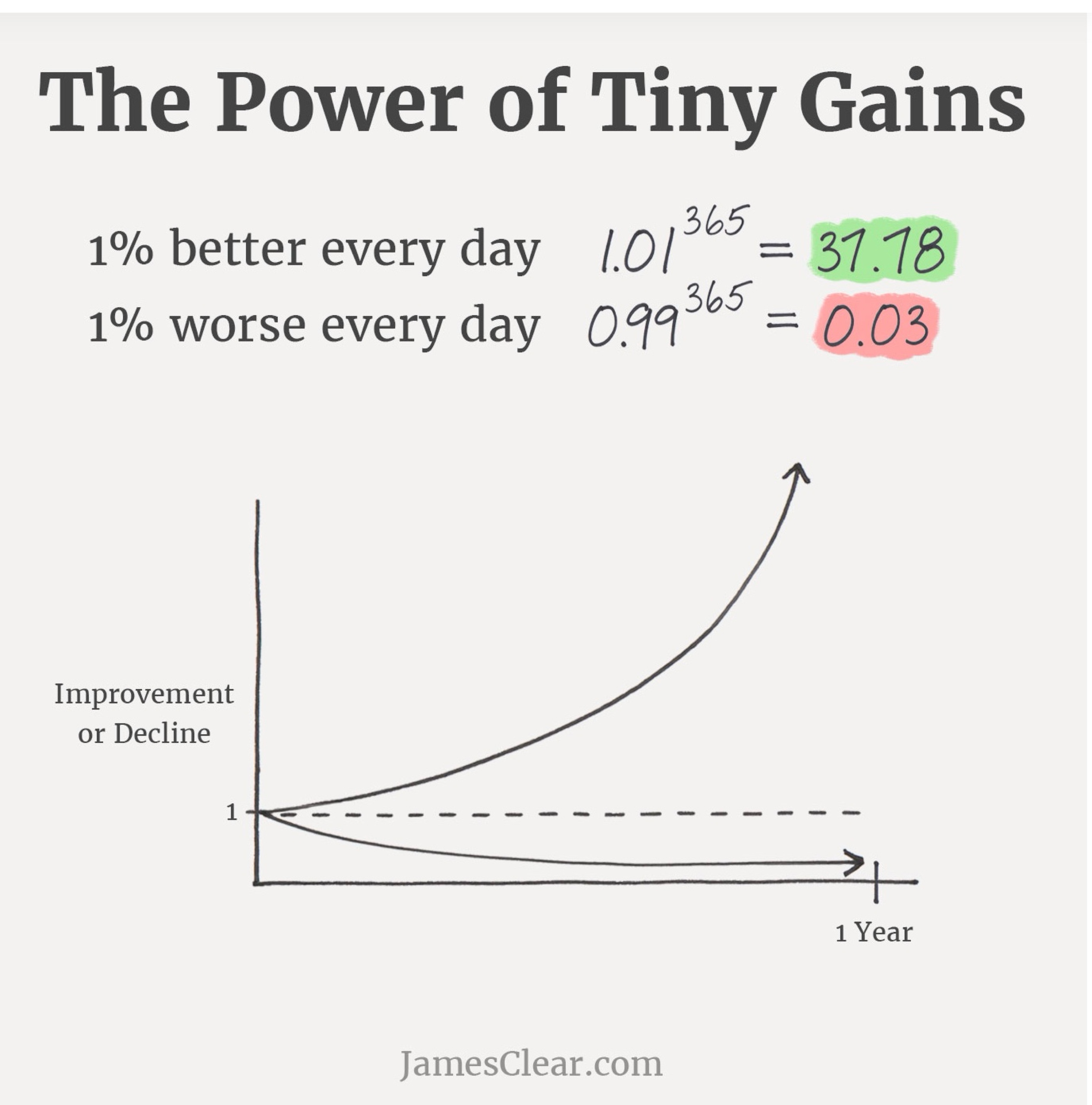
You can see how compatible this is with what we’ve been doing, but it’s an interesting graphic on exactly how those improvements add up.
You know about the 80/20 rule? Not the Pareto principle version, which is more about business and productivity, but the idea that most of the time (80%) you stick to eating healthily, or exercising regularly, and 20% of the time you do not. This works really well for moderators, less so for abstainers. It is a little open to interpretation, but maybe the easiest way to look at it is that 4 times out of 5, you choose the healthier option, be that walking up the stairs or eating the healthier choice. Or it could be that if 80% of the time you remember to take your magnesium, or maca, that’s probably good enough. It can just help to remind you that you don’t have to strive for perfect adherence all the time.
Did you do the clarity exercise this week? It’s summarised below for you.
Goals, aims, dreams, plans, desires, habits…. Sometimes it’s worth clarifying what we are looking to do. Not everything has to be stated as a SMART goal (come across those? The acronym stands for Specific, Measurable, Attainable, Realistic, Timely. We’ll go into these a bit), but having only a very vague sense of wanting to be “a bit healthier” doesn’t easily translate into obvious actions. However you want to frame the changes you want to make, one key point is that you need to be able to clearly identify if you have “got there” or not.
For instance, riders would often state that they wanted to be “better riders”. I have stated that I am doing the IDP because I want to be “good” at self-protection. We might have a comparatively clear image in our own minds of what that entails, but it still isn’t a very workable “goal”. You may be able to tell if you are improving but it is equally possible to ride every day, or train every day, and not get any better.
So here’s the exercise:
Write down ten “wishes”, or at least, things that you would like to have happen in your life. They don’t all have to be around wellness and fitness. Perhaps you want to travel more. Or maybe there’s something you’ve always wanted to own (like a camper van so you can travel more). Don’t censor them and don’t initially worry about how they are phrased. So you could indeed say: “I want to have more money”, or “I want to be fitter”, or even “I want to have more time”. Maybe you come up with more than ten, maybe a couple fewer, but find a number of things that you would wish for.
It might be worth setting this as a task for your subconscious to work on whilst you go about your daily life. Whilst out for one of your regular walks, or whilst doing the day’s exercises. Make a note whenever something comes up. But they don’t all have to be big dreams. It’s often the ordinary things of life that make the most difference. “I would like to have 2 hours to myself every day to do whatever I want with” is a pretty radical wish in this day and age!
Now go back through your list and be more specific with at least 5 of them. Imagine that a genie is going to grant your wishes. It’s a common theme in fiction where people get what they wished for, literally, but it wasn’t what they meant. They either hadn’t thought it through, like King Midas, or they weren’t specific enough. You could indeed be granted more money, but even £5 would be “more” and maybe you wanted something a little more life-changing. Definitely if a genie is involved, go for SMART goals (although perhaps if magic is part of it they don’t have to be so Attainable or Realistic, and maybe don’t limit your aspirations at this stage).
Take a bit of time to be really state specifically what it is you want. If your goal is to run a certain distance, state how you want to do that. Easily and with a smile on your face? Or dragging yourself to the last metre as if your life depended on it. Just once? (Which is what happens to most people who run the London marathon), or regularly?
If indeed the idea of having two hours to yourself every day to do what you want with appeals, be very specific. When would you like to do that? If it means getting up at 5am, is that really what you want? That’s not going to work if meeting friends for coffee or even a walk was what you had in mind. Is it to “catch up” on things, or is it to do whatever you fancy? Really, it doesn’t seem that unreasonable to imagine a life where you could get done all that you need to get done and still have some time completely free to spend as you like? If you’ve got young children, or babies, perhaps two hours is a little unrealistic, but one hour could be manageable. If not daily, then at least a few days a week. Imagine what a difference that could make to your life!
Now select the one that resonates the most with you. Or two if it’s really hard to choose, and one could be longer term and one could be shorter term. But in any event, don’t try to work on too many at once. This surprising, maybe even shocking piece of advice from Warren Buffet, mentioned in Four Thousand Weeks by Oliver Burkeman, is known as the 5/25 rule. In it he suggests identifying your top 25 priorities, circling the top 5, and completely ditching the remaining 20. Even though they are priorities for you. Focus totally on the top 5 (best to choose wisely), and don’t give any of your precious time, energy and attention to the other 20 unless and until you “complete” your first 5 priorities, if they even are things you can “complete”.
Warren Buffet was clearly not a busy woman, so perhaps 5 is actually too optimistic. The point is we can’t get done everything we want to do, however organised we are, so it’s not just a question of saying no to the things we don’t want to do, we also sometimes have to say no to the things we do want to do.
The difficulty would be working out what it is that we really want to prioritise.
We keep talking about the whys, but they are really important, and this little step can be really useful.
Ask yourself why? And answer with “so that” as many times as you can, at least three.
It might look like this:
“I want to own a camper van”
Why?
“So that I can go on holiday at short notice”
Why?
“So that I can take a break, and explore my country more”
Why?
“Because I really want to get away from the day to day of my life and feel the expansiveness of being somewhere new”
Why?
“Because getting into a new environment boosts my productivity and feeds my soul”.
In this case, the campervan would indeed facilitate what you want, but it’s not the only way of doing it, and the “owning” it part isn’t essential. Sometimes doing this exercise makes it clearer that what you want can be achieved in many different ways - perhaps in even better ways than the solution you had fixed on as perhaps the first obvious choice. In this case, the “whys” don’t really mention anything specific about the campervan. They don’t all lean towards how fun it is to live in a tiny space, to have everything that you need with you on wheels, that sort of thing. If they had, then perhaps part a possible solution would be hiring one, or finding a way to jointly own one with one or a few other people.
Then come up with all the ways you might achieve “that” (which you might have re-written to more clearly reflect your desires). Again, be creative, inventive, don’t censor yourself. If your stated wish was to have two hours to yourself every day, how could you possibly do that? Bunking off and not telling anybody could be one option. The fact that you probably wouldn’t do that is not the point. The idea is to take the brakes off your imagination.
Some of the ideas you come up with might be totally impractical and you can discard them immediately, but sometimes something you thought was unlikely actually turns out to be quite possible.
Thinking of the previous example, getting access to a campervan might be easier than you think. It might be that someone has one but doesn’t use it as much as they thought they would and would consider part ownership (they can’t generally hire it out as such without different insurance, but they may well be able to share it). Or, the “why” exercise revealed that it wasn’t really the campervan, it was the getting away, and an airbnb would do the trick, or even a house swap - there are plenty of those available online.
For many women, giving ourselves permission to prioritise our own well being is challenging. Unless you are in quite an unusual situation, however, it is unlikely that anyone else will do that for you! But we only get one pass through this, we might as well make it as good as we possibly can, right?